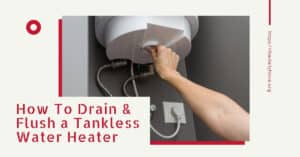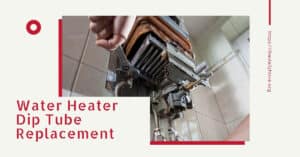Every homeowner knows the frustration of waiting for water to heat up, and the precious water wasted in the process can be quite significant, especially over time. An under-sink water heater can be a game-changer in this scenario, saving you hundreds, even thousands of gallons of water annually, particularly if installed at a sink far from your main hot water supply. Say goodbye to the annoyance of waiting and the unnecessary water wastage. Plus, a happy wife equals a happy life, right?
Under-sink water heaters, also known as sink water heaters, inline water heaters, or point-of-use water heaters, are compact units designed to be installed directly at the point of use, providing hot water almost instantaneously. These units come in various sizes, starting from modest 2 1/2 gallon models, catering to different needs and spaces.
The beauty of these small water heaters is their versatility. While they’re perfect for installation under the sink, they’re not limited to that location. They can be placed wherever you need rapid hot water access. Due to their compact size, the smaller units are especially convenient, offering the ease of plugging right into a standard wall outlet. This adaptability makes them an ideal solution for various settings, providing immediate hot water exactly where needed ensuring convenience and efficiency in your daily routine.
What Is an Under-Sink Water Heater?
An under-sink water heater is a compact appliance that fits directly under a sink and provides hot water without the delays associated with larger, centralized water heaters. These small units are designed to deliver hot water where needed, precisely when needed, avoiding running water through pipes from a main heater to the faucet. This immediacy brings convenience and reduces water wastage, making these heaters both efficient and eco-friendly.
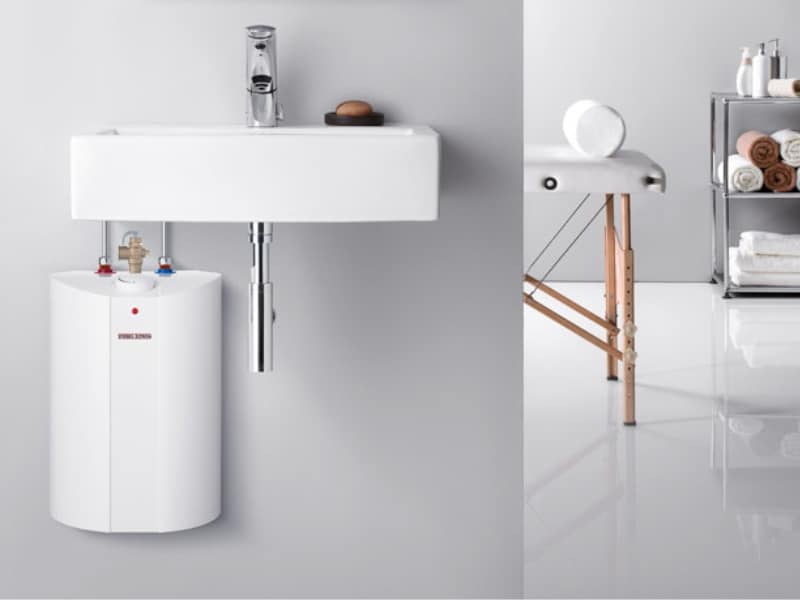
These heaters are typically installed near the point-of-use, meaning they are often situated under the sink to serve immediate hot water needs for activities such as dishwashing or handwashing.
How Do Under-Sink Water Heaters Work?
The functionality behind under-sink water heaters is ingeniously simple yet highly effective, ensuring that you get hot water exactly when you need it, without any delay.
Here’s how they operate:
- Inline Filter: The system begins with the inline filter connected directly to the cold water supply line. Its primary role is to purify the water by removing any impurities. This step ensures the heated water is clean, enhancing your household’s health and safety standards.
- Dual-Chamber Heating Tank: After filtration, the water flows into a unique heating unit designed with two separate chambers. One chamber holds the incoming cold water, while the other is dedicated to heating it and maintaining it at a preset temperature, ready for instant use.
- Instant Heating and Delivery: As soon as you turn on the hot water tap, the system triggers the release of the pre-heated water from the tank into your faucet, providing immediate hot water. Simultaneously, cold water flows from the holding chamber into the heating chamber. Here, the water is quickly heated to the required temperature, ensuring a consistent hot water supply without delay.
- Continuous Supply: This process of shifting water from one chamber to another and instantaneously heating it is seamless, providing a continuous hot water supply. Despite their compact size, under-sink water heaters are mighty, capable of meeting typical hot water demands for various tasks like cooking, cleaning, and bathing.
The under-sink water heater’s design eliminates the common inconveniences of waiting for hot water to travel from the main heater, situated far from the point of use. It saves water and energy and ensures that hot water is consistently available, contributing to a more efficient home and happier family life.
Types of Under-Sink Water Heaters
There are primarily two types of under-sink water heaters: tank and tankless.
- Tank Heaters: These contain a small reservoir of hot water, usually between 2 and 7 gallons, ready for immediate use. They maintain the water at the desired temperature, ensuring instant availability. However, once the tank is emptied, it needs time to reheat the water.
- Tankless Heaters: Also known as on-demand water heaters, these systems heat water directly as it flows through the unit. They deliver a continuous supply of hot water without the need for a storage tank, making them particularly useful in situations with limited space.
Key Considerations Before Buying an Under-Sink Water Heater
Embarking on the journey to purchase an under-sink water heater requires careful thought and consideration. Various factors will influence your decision, ensuring you select a unit ideal for your space, needs, and budget.
Here’s a comprehensive guide to the essential elements you need to evaluate:
- Size: First and foremost, assess the available space in your kitchen or bathroom. The physical dimensions of the water heater must accommodate your specific area, allowing for a proper fit and adequate ventilation or clearance. Measure the designated space and compare it to the dimensions of the heater you’re considering.
- Capacity: Reflect on your hot water needs. The capacity of under-sink water heaters varies, with options including tankless models or mini-tanks ranging from 2.5 to 7 gallons. Your household’s demand for hot water will dictate the appropriate capacity. Opting for a larger tank may be prudent if you require a continuous supply for tasks like dishwashing or prolonged showers.
- Energy Efficiency: Under-sink water heaters generally consume less energy, but efficiency variations exist among models. An energy-efficient model, although potentially more expensive upfront, will save money in the long run through reduced electricity bills. Check for energy ratings or certifications on the models you consider.
- Safety Features: Ensure the selected unit is equipped with essential safety features. Thermostat controls allow for easy temperature adjustment, enhancing user safety and comfort. Additionally, look for models with modulation capabilities, ensuring the heater can adjust heat output relative to water flow rate, thus maintaining consistent water temperature and preventing scalding.
- Installation and Maintenance: Installation requirements differ among water heaters. Some units are plug-and-play, while others require extensive plumbing or electrical setups. Understand the installation process: will you need professional assistance, or is it a DIY job? Consider the maintenance your chosen unit will necessitate over its lifetime, and ensure you’re prepared to keep up with it.
- Price and Warranty: Finally, your budget is a significant determinant. Balance cost with quality, and don’t compromise essential features for a lower price. An extended warranty is also valuable, as it provides a safety net and can testify to the product’s durability and the manufacturer’s confidence in its performance.
- Redring Instant Water Heater: While considering options, look at specific models like the Redring Instant Water Heater, known for its efficiency and reliability. Compare its features, cost, and user reviews with other models to determine if it aligns with your needs.
By considering these crucial factors, you position yourself to make an informed and beneficial decision, acquiring a water heater that will serve you efficiently and reliably for years to come. Remember, this investment is not just about immediate needs but long-term satisfaction and utility.
Best Under-Sink Water Heaters – 2023 Reviews
Selecting the right under-sink water heater involves balancing several aspects, including reliability, efficiency, space requirements, and budget. Certain models stand out among the plethora of options on the market due to their performance, user-friendly features, and customer satisfaction ratings. Here’s a deeper insight into some top models:
Bosch Electric Mini-Tank Water Heater Tronic 3000 T
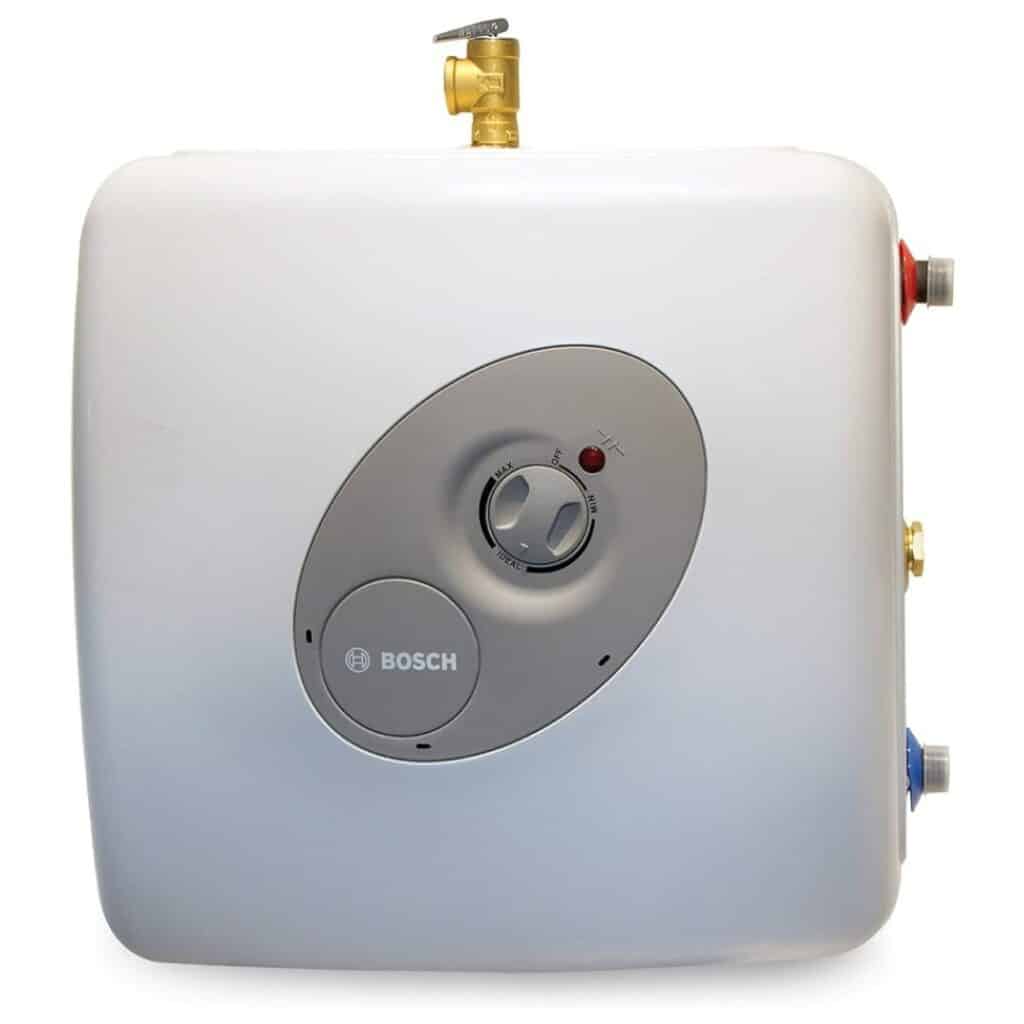
A standout in the realm of under-sink water heaters, the Tronic 3000 T series is renowned for its compactness and straightforward installation. Ideal for fitting into cabinets or even mounting on the wall, these heaters come in sizes that range from 2.5 to 7 gallons, offering a variety that caters to different user needs. Their efficiency in heating water helps reduce utility bills, and the units are well-insulated, maintaining water temperature even when idle. Moreover, the Bosch Tronic 3000 T has garnered praise for its durability and minimal maintenance requirements, making it a cost-effective option in the long run.
EcoSmart ECO MINI
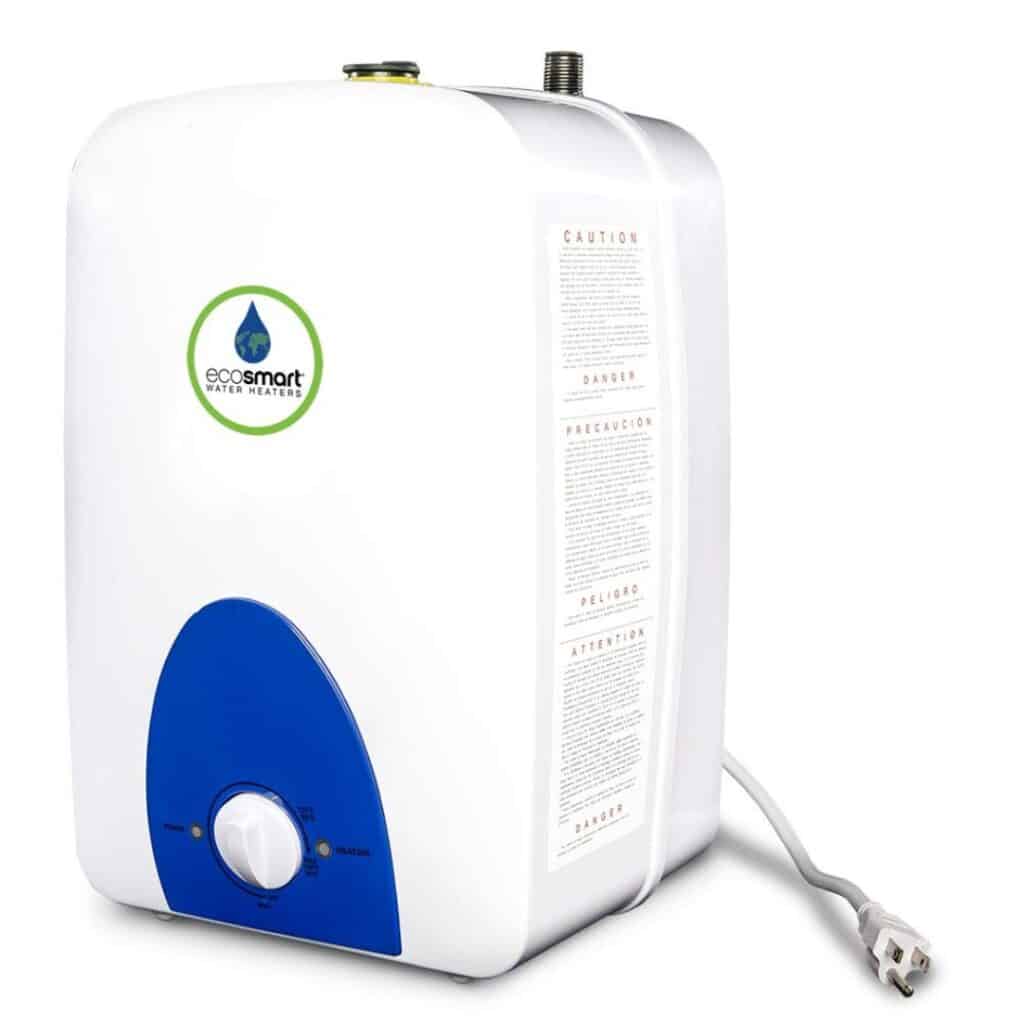
EcoSmart is synonymous with energy efficiency, and the ECO MINI series is no exception. These under-sink water heaters impress with their ability to balance capacity and compactness. The digital display and adjustable temperature control allow for precise and convenient operation, catering to specific preferences. The ECO MINI’s advanced flow control technology also ensures consistent performance, automatically adjusting energy consumption based on water demand, making it a favorite for environmentally conscious homeowners. Its compact design does not steal valuable space and can be installed without a fuss.
Stiebel Eltron Mini-Tank Electric Water Heater
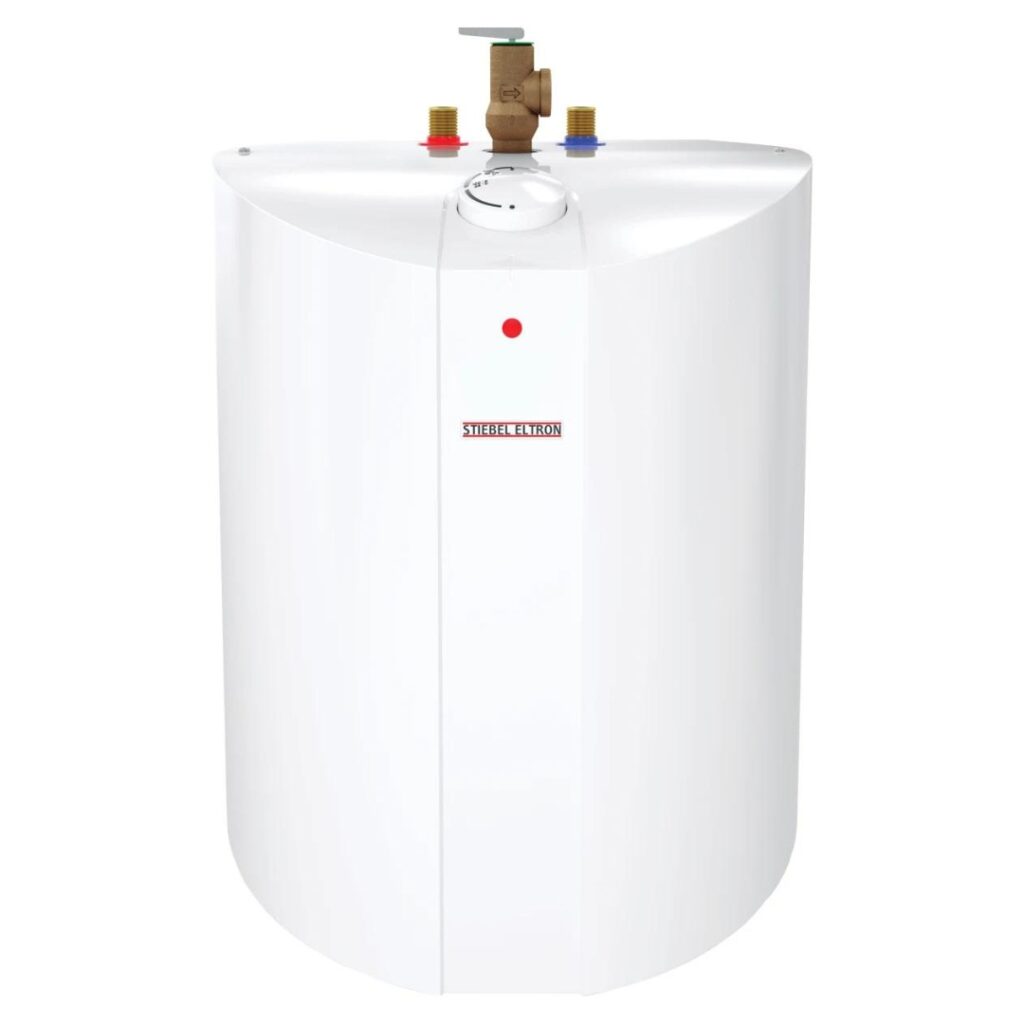
Stiebel Eltron’s options reflect a commitment to quality and efficiency. These mini-tank heaters feature an elegant design that doesn’t compromise on performance. Available in multiple capacities, they’re perfect for various residential and commercial applications. One of the key benefits is the thermostat’s precision, which maintains the desired water temperature, ensuring comfort and efficiency. The units also boast excellent safety features, including protection against dry starts and a high-limit switch, safeguarding both the user and the appliance.
Selecting the best under-sink water heater is not just about the brand or model.
Consider the installation, operational and maintenance costs and how they fit into your budget. Evaluate your typical water usage and seek units that meet those demands without excessive energy consumption. Lastly, don’t hesitate to contact professionals for advice, ensuring your choice offers the best performance and value for your unique situation.
Remember, an informed decision now can lead to savings and satisfaction in the future.
How Much Does an Under-Sink Water Heater Cost?
The cost of an under-sink water heater can vary significantly based on several factors, including type, brand, capacity, and additional features.
A mini-tank water heater may range from $150 to $350 on average. At the same time, tankless models might cost between $200 and $450, excluding installation fees.
Remember that tankless models may carry a higher upfront cost but can often offset this through lower operating costs over time due to their energy efficiency.
How To Install an Under-Sink Water Heater
Installation processes vary slightly based on the specific model and your kitchen’s setup. However, the basic steps are often similar:
- Preparation: Shut off the water supply and clear the area under the sink. If you’re replacing an old unit, disconnect and remove it before proceeding.
- Mounting the Unit: If it’s a wall-mounted model, secure the heater to the wall following the manufacturer’s instructions, ensuring it’s close enough to the plumbing and power connections.
- Plumbing Connections: Connect the water supply lines to the heater, following the instructions. This step might involve attaching new valves or adapters.
- Electrical Connections: If the unit isn’t plug-and-play, you may need to wire it into your home’s electrical system. A professional should handle this step, especially if you’re unfamiliar with electrical work.
- Final Steps: Turn on the water supply and check for leaks once everything is connected. Then, restore the power supply and set the heater to your desired temperature.
Pros and Cons of an Under-Sink Water Heater
Understanding the advantages and drawbacks of under-sink water heaters is crucial before investing. These systems offer immediate solutions to specific needs, but, like any appliance, they have limitations. Below, we’ve simplified these points into a table for a quick comparative overview.
| Pros | Cons |
|---|---|
| Instant Hot Water: Immediate access to hot water, eliminating wait times. | Limited Capacity: Smaller units may run out of hot water during periods of high demand. |
| Reduced Water Waste: Direct heating at the point of use prevents water wastage. | Installation Costs: Professional installation may be necessary, especially for units requiring electrical hardwiring. |
| Lower Operational Costs: Energy efficiency due to localized heating, reducing overall utility bills. | Space Requirements: Even though compact, they require dedicated space that could affect storage options. |
| Convenience: Ideal for remote areas like guest suites, workshops, or garages where immediate hot water is needed. | Maintenance: Like all water heaters, these units require regular maintenance to prevent scale build-up and ensure longevity. |
Evaluating these pros and cons based on your household’s specific needs, space availability, and budget will help you decide whether an under-sink water heater is the right solution for you.
Final Thoughts
An under-sink water heater emerges as a game-changer in the quest for a more efficient home. These compact yet powerful devices are engineered for responsiveness and energy conservation, providing on-demand hot water exactly when and where you need it. No more idling around, waiting for warm water to commence your daily chores, or fretting over the gallons of water wasted in the process. With their easy installation and space-saving design, under-sink water heaters integrate seamlessly into your home, whether in the kitchen, bathroom, or any utility space requiring immediate hot water access.
By embracing this innovative technology, you’re not just enhancing convenience but actively contributing to a more sustainable living practice by significantly reducing water and energy consumption. Our comprehensive guide is curated to assist you in navigating through the myriad options available, guiding you toward a choice that resonates with your space requirements, usage patterns, and budgetary considerations.
We’re eager to hear more about your journey as you venture into this upgrade. Which model caught your attention? How transformative was the shift to instant hot water access? Your experiences are more than stories; they are real testaments to the effectiveness of under-sink water heaters and can immensely benefit others on the same path. Share your insights, and let’s continue making strides toward efficient and mindful living.




